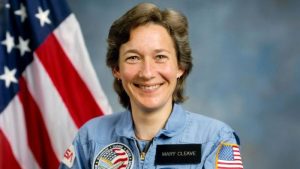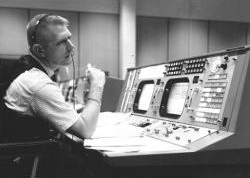Rick Husband
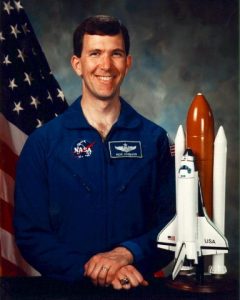
From the time he was a young boy, Rick Husband dreamed of becoming an astronaut. While he was still in grade school, he was hooked whenever he saw live footage of the Mercury astronauts being launched into space. Other kids used to laugh at him when he talked about his dream. Astronauts just seemed larger than life in those days. However, their laughter only made Rick Husband more determined and he wrote to NASA to get the needed qualifications. For quite a long time, he planned his life around his desire to join NASA’s ranks of those larger-than-life heroes.
His favorite subjects in school were math and science and teachers remembered him being a studious young man. English was more of a challenge but he did pretty well once he hunkered down to write his term papers. He was also good at music and acting. In high school, acting roles included the Bottle Dance in Fiddler on the Roof. He insisted on practicing without any Velcro or weights to help keep the bottle on his head. It took a while, but he finally improved his balance enough to keep the bottle upright. He didn’t realize at the time that his future wife was often in the audience, admiring this handsome and talented future astronaut.
He brought the same perfectionist attitude to whatever he tried until his family worried that he would burn himself out. His life wasn’t all work and no play, however. His father got both Rick and his brother Keith jobs in a local packing plant and they enjoyed pranking fellow employees over the company’s loudspeaker system. They thought it was funny to watch someone race to the phone thinking they had a call, only to get nothing on the other end of the line.
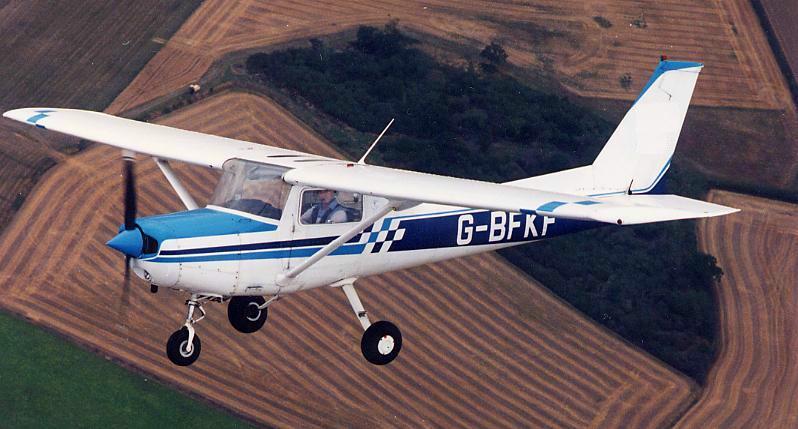
As a teenager, Husband wasn’t very patient about learning how to fly. His parents repeatedly told him that he had to wait until he was at least seventeen. Lessons could cost as much as $1500, which wasn’t exactly pocket change in those days, but he managed to earn the money and learned in a Cessna 152 that looked like a toy to his parents. Being a teenager, he couldn’t resist giving rides to friends and family and occasionally scaring them with stunts like chasing cattle.

He did date, but he didn’t really get serious about any particular girl until he graduated high school and was majoring in mechanical engineering at Texas Tech. He met Evelyn Neely at a basketball game in 1977 and thought she looked familiar. She was the girl who had secretly had a crush on him in high school. He was pretty hesitant about dating a Kappa pledge, but called and invited her out anyway. At a local restaurant, he spilled his water and it spread all the way to her side of the table. Certain that he had just spoiled his chances, he tried to mop it up while she assured him that none of the water had spilled on her. After seeing a movie, they picked a romantic spot by a lake where they could chat. He told her about his dreams to join the Air Force and become an astronaut. He was honest about the fact that it was going to take years of hard work. Husband and Neely dated on and off over the next few years and graduated from Texas Tech in 1980.
Upon graduation, Husband was commissioned in the Air Force and went into training as a pilot. Many of the students in his class washed out from the pressure, because they couldn’t master the needed skills, or because they developed medical conditions that prevented them from flying. Husband hung on through determination and focus.
Evelyn sometimes came out to visit while he was training. His marriage proposal came out as a nervous squeak, but she said yes anyway. Then, after Thanksgiving with her family, it was off to Land Survival School, where he learned how to live off the land while evading the enemy, interrogation resistance techniques, and escape techniques. Next was Fighter Lead-in School, which taught the basic skills needed for fighter planes. He then learned how to fly the F-4 Phantom.
The wedding on February 27, 1982, was a typically Southern, large affair, and then the young couple settled into the life of a nomadic Air Force family. Evelyn learned quickly how to turn a new house into a home while Rick Husband was off flying Phantoms. While in Homestead, Florida, his first sight of the Space Shuttle was a glimpse of a streak of light as it orbited overhead. Though he wasn’t too thrilled about getting up at three in the morning to see it, he was quick to point it out to Evelyn. “Can you believe it’s traveling over 17,000 miles an hour?” He was already well on his way towards his dream of becoming a shuttle astronaut, but it would still be years of work with God’s own timing as an important factor.
He needed at least one thousand hours flying fighter jets, which could take six or seven years. Being part of a squadron means more than just flying high-performance jet planes. At one point, he was helping with the complex job of scheduling seventy-two crew members. Colleagues remembered him as a thorough professional who never let the stress of the job get to him.
In December 1985, Husband was assigned to George Air Force Base in an area of California that Evelyn later described as “the middle of nowhere”. Along with training pilots and weapons systems operators, he continued to accumulate flying hours and worked towards his Master’s degree at Cal State Fresno. Evelyn tried becoming a real estate agent for a while and then became a substitute teacher at a local junior high school. They attended the same church as Roy Rogers and Dale Evans but their spiritual growth was still in its infancy.
Just to see what would happen, Rick Husband sent his application to NASA for the first time. The Challenger disaster in January 1986 caused the entire space program to be put on hold, including the acceptance of new astronaut candidates, so the application fell through. He continued earning his credentials by applying to the Test Pilot School at Edwards Air Force Base.
Competition was tight. The Test Pilot School only accepted a maximum of twenty-five students in each class. Each candidate would have to perform a series of precision maneuvers perfectly to get in. Husband couldn’t afford to be a stereotypical hotshot pilot with something to prove or goof around in the cockpit. He spent hours studying maneuvers and skipped out on social activities so that he could spend more time preparing.
When Colonel Gene Patton informed him that he had made it, he leaped out of the chair and paused just long enough to enthusiastically shake Colonel Patton’s hand before running out of the office to call Evelyn. They were already close enough that Husband was familiar with the airspace and the hardest part of moving was saying goodbye to friends. As they found out fast, Edwards was even more “the middle of nowhere” than George Air Force Base was. Edwards had grown since its glory days, during which the first sonic booms were heard in the desert skies, but there were still no sizable towns nearby.
They quickly made new friends, though, and a close friend named Pat Daily had made it into the class as well. Like Rick Husband, Daily also had the dream of becoming an astronaut. Daily remembered that Husband sometimes went out of his way to help others who needed it, quite unlike some pilots who took an every-man-for-himself approach.
The hours were brutal and Husband often had to take extra time to get acquainted with an unfamiliar airplane. It didn’t allow a lot of time for family. Evelyn used the extra time to start studying the Bible more closely and began developing a closer relationship with God. Rick’s faith was growing more slowly, but he agreed to a baptism in the base pool.
Just before his graduation at the Test Pilot School, Husband sent in his NASA application for a second time. It never made it past the Air Force level. The process was a frustrating one for Husband. People who had only limited contact with NASA officials were making decisions about his future.
While still at Edwards, Husband’s first child, Laura, was born. The couple was thrilled. They had struggled with infertility and came to see the birth of their daughter as God’s own timing. Husband spent a lot of his free time with Laura.
In March 1991, he applied to NASA again but lied on his application about wearing hard contacts. He reasoned that others had used hard contacts before without a problem. He had also heard that another astronaut had lied about the same thing and gotten in. He wouldn’t have been the only astronaut to fall into the trap of “Everybody else is doing it” when making decisions that would affect their lives. Years later, he admitted in his journal that he regretted letting his own selfish desires overcome his integrity and faith in God
This time, he made it as far as NASA’s medical and psychological testing. He especially remembered being placed in a pitch-black ball that was only three feet in diameter and having to stay in a fetal position inside. The idea was to see how long he would last without cracking. He fell asleep.
The eye exam made him nervous because he thought the doctors would detect that he had lied on his application. He never knew for certain whether they had or not.
Finally, all he could do was go home and wait. He got a phone call to inform him that he had been rejected yet again. He was disappointed but tried not to dwell on it. He would only focus on applying again when it was time.
While he waited for his next chance, he became more serious about growing in his faith. He learned more about the power of forgiveness and how guilty feelings could hold a person back in his relationship with God. He attended Bible studies more seriously and another member of his church helped him study a book called Point Man by Steven Ferrar, which covered the idea of being a spiritual leader in the home.
His next career move took him overseas to England as part of an exchange program with the British Royal Air Force. It was considered an honor to be selected and Husband was confident that it would be a good step forward in his dream of becoming an astronaut. He noted in his journal that becoming an astronaut would happen if and when God decided to make it happen. The family again went through the process of saying goodbye to their friends at Edwards and preparing for the move.
England took some getting used to. They had to make do with Royal Air Force furniture and a black-and-white TV that mostly turned out static. The late-summer days were still long enough that the family bought blackout shades to keep from being woke up at four in the morning by sunlight in their eyes. He was assigned to the Fixed Wing Test Squadron, commanded by Nigel Wood, who would have been the first English man in space if the Challenger accident hadn’t occurred.
They quickly made friends with Angus and Carole Hogg from Glasgow. Both of the Hoggs had Scottish accents so thick that Evelyn had trouble understanding them at first. Fortunately, Rick Husband understood them fine and both were happy to discover that they shared the faith. The Hoggs were impressed by Husband’s sense of humor and a sense of humility that was rare in test pilots. Angus was a fellow test pilot who often flew with Husband as a navigator and also helped Husband with lingering slackness in his spiritual life.
His work with the Fixed Wing Test Squadron included learning about low-level flying and tactics. He was flying at an altitude of 300 feet at hundreds of miles an hour in a British airplane called the Hawk. Foul weather and the presence of nearby mountains tended to make it challenging. If something went wrong, he probably would have left not much more than a smoking hole somewhere in England. He also learned about British aircraft like the Buccaneer, two versions of the Tornado, and a bright yellow plane called the Harvard that he sometimes flew over the small house where his family was staying.
When he heard that his father was terminally ill, he flew back just in time to say goodbye. It was devastating. The last time he had seen his father, they had driven his car from Edwards AFB to Texas, where his parents lived, just before his move to England and he cherished the memory of the time they had spent together.
While living through this jolt, he still wrestled with his dream of becoming an astronaut. Was it something God wanted for him? Was the timing right? He thought of a Bible verse that read, “Delight yourself in the Lord and He will give you the desires of your heart. (Psalms 37:4)” He had to analyze the real desires of his heart. “I want to be an astronaut” felt like a knee-jerk answer by this point. If he had become an astronaut in one of his previous attempts, he might have sacrificed his family or his relationship with God, losses that he would have regretted for the rest of his life. He finally decided to try and live a God-centered life and be a good father and husband and let Him take care of the rest. He prayed that if God didn’t plan for Rick Husband to become an astronaut, He would take the desire away.
The desire remained in the back of Husband’s mind and, in March 1992, he decided to fill out another application. He wrestled with the fact that he had lied about wearing hard contacts on the last one and decided to be honest this time. He spent an entire two-hour drive to the nearest post office wrestling with doubts. Would NASA realize that he had lied and just toss the application this time? However, he felt like God was encouraging him in the back of his mind and he dropped it in the mail. “Okay, Lord, let’s just see what happens,” he later said of his feelings at the time.
The next day, Husband heard that there was going to be a space shuttle briefing for anyone who wanted to attend. While at the briefing, he recognized an ESA astronaut named Jean Claude Nicollier, who had been working at NASA the last time Husband had applied and had let him sit in on a Shuttle simulation session. It was like God was sending him a signal that he had done the right thing.
He had to wait more than a year for word that he had made the list of potential candidates. Friends reported getting calls from the FBI and NASA, asking about Rick Husband. He took that as a sign that NASA was interested and was covering the usual bases. Finally, Husband got the call he had been hoping for. He was going to return to the United States for interviews.
He had a better idea of what to expect this time around. With friends and family praying for him, he felt that he was able to hold his ground and even improved on a test of his vision. Even so, he knew it was going to be close. Every applicant was qualified to be an astronaut and NASA’s final selection could come down to minor details. Still, he felt that God would vindicate him and he celebrated the end of the process by splurging on a rental car so he could have a burger and milkshake at a favorite local burger place.
After that, he returned to England to wait. In December 1994, he was promoted to lieutenant colonel. When he got the call, he drove his wife nuts by giving her no other indication than a thumbs-up. When he hung up, he told his family that he had been selected as one of a class of 19 astronauts.
Saying goodbye to Angus and Carol Hogge was a real tear-jerker. Husband was convinced that he couldn’t have done it without their help with his spiritual growth. The Hogges said they missed his natural humility and leadership skills after his departure.
The move to Houston was made even more complicated by Evelyn’s pregnancy with their second child and Rick’s jump right into fourteen months’ worth of Astronaut Candidate training. They became friends with Michael Anderson, who was in the same astronaut class, and his wife Sandy. Training took the entire astronaut class across multiple states and Husband often came home exhausted. He still tried to make time for the family, though it was never as much as he would have liked. It seemed like he could never get everything done that he wanted in a day. He even dozed during the birth of his son, Matthew Douglas, on August 3, 1995. He eventually had to learn where to draw the line or he would have keeled over from overwork and lack of sleep.
Training for Shuttle pilots included sessions in the Space Shuttle flight simulators, during which they learned how to handle a wide variety of emergencies. The simulator could rotate to a vertical position to simulate the shuttle orientation during launch. Husband was laying on his back and staring up at the controls. He commented later that he felt like his IQ had plummeted while trying to work controls that suddenly looked different.
He also received training in NASA’s fleet of T-38 airplane to stay current and worked with a modified Gulfstream airplane called the Shuttle Training Aircraft (STA). When planes lose power, they never just fall out of the sky like in the movies. They become gliders, which gives the pilot time to find a safe landing area, and training on the STA relied on that idea. When the engines were turned off, potential Shuttle pilots could simulate the Shuttle’s gliding towards one of the designated runways during reentry.
Rick Husband made it through basic training but still had to wait for a flight assignment. He ended up being the last pilot in his class to get one. When he became the Pilot for STS-96, he could now park closer to the Johnson Space Center and his class celebrated by making him a cake shaped like a parking space.
STS-96 Documentary

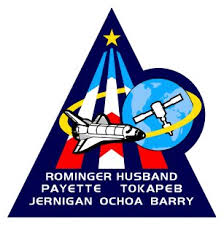
Kent Rominger was the Commander for STS-96, which was the first to actually dock with the International Space Station and delivered an Integrated Cargo Carrier. Construction of the space station was just getting started and the lack of a planned docking module meant changes to the rendezvous plan. The crew spent nine months training for the mission and bonded easily under Rominger’s capable leadership. They liked Husband’s sense of humor (“You can’t swing a dead cat without hitting an engineer around here!”) and his compassionate attitude towards those he worked with.
As the pilot, Husband was in charge of the electrical systems, auxiliary power, orbital maneuvering system engines, attitude control jets, and the shuttle main engines during ascent. He worried about mastering all the systems in time. He finally reached the point where late-night study sessions did more harm than good, so he set a strict bedtime and his performance improved.
As the launch day approached, he selected items for his Personal Preference Kit (PPK) that included Evelyn’s wedding ring. He went into quarantine with the rest of the crew to help cut down on the risks of illness. Only immediate family members and NASA personnel who had business with the crew could visit if they had been screened by medical doctors and no children were allowed. The crew shifting their sleep schedules to help their circadian cycles adjust for the flight. It was somewhat disconcerting for family members to visit in the evening and hear “Good morning!” from crew members who were just waking up.
On the last day before the flight, Rick Husband got some time with Evelyn in a renovated beach house not far from crew quarters. He promised to pray for the family during the flight. Both of them were aware of the risks but tried not to worry.
Launch day began early for the crew. By 4:00 am on May 27, 1999, they were strapped into the Space Shuttle Discovery. Rick Husband was finally attaining his lifelong dream. His excitement did have an undercurrent of tension. Several astronauts had admitted to being as afraid of messing up and letting everybody down as they were of dying in an accident. He stayed focused on the readouts in front of him.
Liftoff occurred at 6:48 am, Eastern Standard Time, and the rocket propellant produced 7.5 million pounds of thrust to accelerate the space shuttle from 0 to 17,500 miles per hour in 8.5 minutes. This was one of the most dangerous parts of the mission. The Challenger had been destroyed because some rocket propellant leaked through a damaged part of the O-ring. There was no way to shut down the rocket engines if something went wrong.
Husband’s family was certainly tense enough during the launch, but the tension changed to excitement once they saw that he had made it. His son Matthew reportedly turned into a chatterbox until somebody distracted him with some stickers, and then nearly caused some mischief again by sticking them on a door filled with stickers of mission patches. Something distracted him just in time.
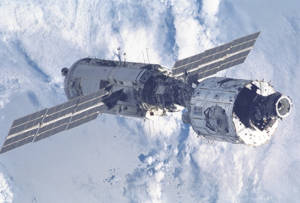
Unaware of the excitement Earthside, Husband focused on coping with the G-forces and keeping his attention on the controls. Discovery made it into orbit safely and acceleration suddenly changed from 3Gs to 0G, throwing the entire crew against their straps. They spent the rest of that day and most of the next catching up with the International Space Station. Discovery had to adjust its approach to the space station to allow for the lack of some planned docking hardware and finally docked at 11:24 on May 28. The station didn’t have a crew yet and the crew’s duties included delivering more than a ton of supplies that would help make it habitable.
The next day, Mission Specialists Dan Barry and Tammy Jernigan conducted an EVA that included installing two cranes for moving large equipment outside the space station along with hand- and foot rails, tools and supplies that would be used on future spacewalks. Their EVA lasted 7 hours and 55 minutes, which was then the second longest EVA on record.

Over the next few days, the crew moved cargo from Discovery to the International Space Station for installation. The cargo included acoustic insulation shielding around fans to reduce ambient noise levels, equipment stowage racks, and various logistical equipment necessary for keeping the Space Station running smoothly. Rick Husband and Dan Barry replaced a faulty power distribution unit and transceiver in the Early Communications System.
For all the hard work, the crew did find time for fun. They spent a lot of their free time Earth-gazing or watching one of the swift, bright sunrises and sunsets that happened every 90-minute orbit. Each of them had an opportunity to chat with their families and Husband laughed at a funny story of his mother falling and making a hole in the drywall at their home while sneaking downstairs for some ice cream. She wasn’t hurt any worse than a bruise on her foot.

On Flight Day 6 (May 31), ground controllers played George Strait’s “Amarillo by Morning” for Rick Husband. He had been part of those 6:00 pm “Good Mornings” while in quarantine and his day began at about the same time. He spent most of it moving various packages of cargo from SpaceHab into the International Space Station. By the time his day ended at 7:00 am on June 1, more than half of the planned cargo transfers and all the large pieces had been transferred to the station.
Day 7 included interviews with Good Morning America, KFDA-TV in Husband’s hometown of Amarillo, Texas, and KUSA-TV in Rominger’s hometown of Denver, Colorado. By the end of the day, most of the cargo transfer had been completed and the crew took some time for a few “get-ahead” tasks that included installing a wireless strain gauge system that would track the effects of future installations on the station.
Early in the morning of June 3, the crew made the final cargo transfers and closed the hatch for the final time. That evening, Discovery undocked and Rick Husband fired thrusters to back away from the station. They flew around the International Space Station, which must have looked pretty small compared to what it would be once it was completed. While the crew packed away the gear they had used on the station and during the EVA, Husband and Rominger used a laptop to practice reentry procedures.
That done, they caught some shuteye and then prepared for the deployment of a satellite called STARSHINE, which would be controlled by students on Earth to study the density of the atmosphere. It was expected to last about eight months in orbit. Mission Specialist Julie Payette handled the actual deployment and project officials reported spotting it from the ground as it maneuvered away from Discovery.
June 5 was their last full day in orbit. That evening’s wakeup call was a song called “The Longest Day,” which commemorated the anniversary of the Allied troop landing on the beaches of Normandy in 1944. The crew made the final preparations for reentry and then took their seats for a rare nighttime landing. The shuttle landed at 2:00 am on June 6, 1999.
STS-96 As Narrated By The Crew
Once the initial post-flight duties were taken care of, Evelyn took him to Subway for a sandwich and a Coke. He thoroughly enjoyed the smell of the sandwich with real, fresh-baked bread. They could only eat tortillas in space because of the threat of floating crumbs and no food made for Shuttle missions had a very noticeable smell. He entertained the family with stories of the flight. “I can’t wait to go back,” he told Evelyn.
Now that he was back on Earth, he had to get back in line for another flight. Reporters were well aware of Rick Husband’s faith in God by this point and asked him about his views on science and its relationship with religion. Husband saw no contradiction in using science to study God’s creation. Instead, he saw it as a way to appreciate the complexity that God had worked into the universe: “It’d almost seem that you have to have more faith to accept that it happened by chance than to accept that God created the universe.”
After the usual post-mission PR tour that had the crew traveling throughout the U.S. and Canada (Julie Payette is Canadian), life began to return to normal. Rick Husband took a position in the astronaut office and kept up with his training in anticipation of another mission. With a lot of prayer, he had finally found a good balance between work and home and Fridays were designated Family Night. Besides movies, pizza and games, the family found time for Bible study but the parents found holding the attention of four-year-old Matthew to be difficult. Things began improving marginally when they began inventing fun activities at the end of each lesson. Over time, Evelyn began to feel that God was preparing them for another major change in their lives. Then, Rick Husband learned that he had been assigned to the crew of STS-107 as Mission Commander.
It was fairly unusual for a Pilot to be promoted to Mission Commander before he had flown two missions but NASA was facing a crunch in astronauts qualified for the position right then. This particular flight was getting a lot of international attention because of the presence of Israel’s first astronaut, Ilan Ramon, and India native Kalpana Chawla. The NASA employees most involved in crew assignments maintained that they had picked Husband for the position because they knew he could handle the pressure. Humble as always, he gave STS-96 Mission Commander Ken Rominger credit for showing him how to lead a Shuttle crew.

Besides Rick Husband, the crew consisted of Pilot William McCool and Mission Specialists Michael Anderson, Dave Brown, Laurel Clark, Ilan Ramon and Kalpana Chawla. Husband, Chawla and Anderson each had one space shuttle mission under their belts. The rest would be flying in space for the first time. Husband was impressed with the abilities of each of them and prayed that he wouldn’t let his crew down.
STS-107 was delayed due to needed repairs to Columbia and delayed again because the shuttle was needed for a Hubble Telescope repair mission. It would have been easy to get frustrated but Husband did his best to take it in stride. During the wait, he heard from another astronaut about the National Outdoor Leadership School and thought it would be perfect as a team-building experience. Roughing it in the Wyoming wilderness was an excellent way to bring out the strengths and weaknesses of any crew along with building many of the personality traits that NASA wanted in its astronauts.
The NOLS teachers detected early on that the entire crew looked to Husband as their leader in every way. He had been through the same survival training as every other astronaut but didn’t consider himself an expert at surviving the wilderness of Wyoming. A quick discussion with the NOLS personnel cleared up the issue. In fact, Andrew Cline and John Kanengieter had been worried that they would have to deal with seven egos for two weeks, but none of them came off that way at all. They weren’t afraid to work hard, but they also knew how to have fun. During the entire two weeks, they hiked, took turns with leading and various camp chores, played a seemingly endless cribbage tournament with Cline and Kanengieter winning most of the time, and challenged their teachers to a wilderness version of hide and seek. Cline and Kanengieter expected the latter to be an easy one, but found out otherwise when the crew set up an ambush along a ridge they couldn’t avoid.
They were in the mountains and Rick Husband suffered from altitude sickness one day. The weight of his pack was distributed among the rest of the crew. He tried to make the best of it, even doing his best Eeyore impression: “Don’t worry about me, I’ll manage somehow.” He admired the scenery to try and keep his mind off the nausea and pounding headache. After a good night’s sleep, he felt much better.
They certainly found out about each other’s quirks. Kalpana Chawla had a tendency to micromanage. Ilan Ramon was stubborn about not eating breakfast. Laurel Clark was curious about nature and not afraid to investigate some scat that the NOLS teachers told her was moose. Willie McCool was the competitive one; in fact, the hide-and-seek idea had been his. Michael Anderson was cautious about not taking any unnecessary risks and hesitated to climb some boulders that looked unstable to him. Dave Brown was an incorrigible shutterbug and actually starting making a mini-movie out of the trip with his video camera. Rick Husband managed not to annoy people with his faith, but he wasn’t shy about it either and the mountain views inspired him to sing “Amazing Grace” even when his headache was at its worst.
After two weeks, the crew made it back to civilization feeling more like a coherent team. Their mission had been pushed back even further as a side effect of delays in the Hubble repair mission and some reshuffling in the space shuttle launch schedule. The crew might have been justified in getting a little impatient. However, they just kept on with their training and even managed to drive the training crew nuts by doing a simulation run without saying a single word. By this point, they knew one another so well that they could use hand gestures to communicate.
Rick Husband used the extra time to start rehearsals with his church’s choir for Easter services. He was slated for several solos. He also celebrated his twentieth wedding anniversary and somehow found the time to take his children to Disney World. Even though they now had a January 2003 launch date, he gave his crew some time off over Thanksgiving and Christmas so they could recoup from all the pressure. Shortly after New Year’s Day, the Husbands had dinner with Michael and Sandy Anderson and talked about what would happen to their families if they didn’t make it back. The families of the Challenger‘s last crew had gone through a difficult time after the accident and they didn’t want the same thing to happen to theirs. They prayed that the mission would be a success and their families would be all right if something did happen.
Finally, launch day began to close in and the crew went into quarantine. Saying their farewells to their families was tough and Rick Husband’s daughter Laura broke down when they hugged. He had made some video devotionals for them to watch while he was in space and done everything he possibly could to make sure they would be okay.
The crew divided into the “Red Team” and “Blue Team” and began sleeping in shifts to adjust their schedules. Husband was on the Red Team with Laura Clark, Ilan Ramon and Kalpana Chawla. He had a long list of things that needed doing before the launch and at the end he had written, “Build Rome in a Day.” It was his way of acknowledging the difficulty of getting his list finished.
Husband got to walk on the beach with Evelyn on the last day of their flight. She told him a funny story about getting her police escort to help with grocery shopping and, when they kissed, she asked, “There isn’t an escort watching, is there?” Because of the presence of Ilan Ramon, security for the families and around the Cape was tighter than normal to prevent any kind of terrorist threat. It was the last time they could be together.
January 16, 2003, began bright and early for the crew of STS-107 and they were boarding the Columbia by 8:00 AM. Rick Husband, sitting in the left seat on the flight deck, commented, “The Lord has blessed us with a beautiful day here, and we’re going to have a great mission.” Kalpana Chawla was sitting in the center seat, just behind Husband and Pilot William McCool. As the flight engineer, it was her job to act as a third pair of eyes on the readouts and alert the Commander and Pilot if something was wrong.
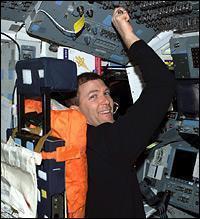
The launch looked normal to most of the people watching on the ground. Some of the launchpad’s cameras caught pieces of foam flying off the External Tank and one of them struck Columbia‘s wing, damaging the thermal tiles designed to protect it during reentry. Without realizing the danger, Mission Control told Columbia, “Go for throttle-up.” Husband acknowledged as the watching families tensed. The Challenger had disintegrated at this critical moment. However, Columbia passed through throttle-up and into orbit without any apparent problems.
Once they settled into orbital operations, the STS-107 crew jumped right into their duties of activating eighty experiments. These experiments included MEIDEX, a study of the movement of dust particles in the Mediterranean region that Ilan Ramon would operate, biomedical experiments that included studies of bone density, the cardiovascular system, and protein turnover, and a package of student experiments called STARS that included a look at bees, silkworms and ants in space. The crew sent results of ongoing experiments to researchers daily, ultimately saving about 30% of the total scientific results.
Other than the coverage of Israel’s first astronaut, STS-107 was a boring mission to American reporters who were used to spaceflight. There was no docking with the International Space Station, EVA, or even an operation with the Columbia‘s Robotic Manipulation System. On the other hand, Israel was certainly paying attention and the Red Team had a chance to talk with Israeli Prime Minister Ariel Sharon. Sharon extended an invitation to visit Jerusalem, which Rick was more than happy to accept on behalf of the crew. He would have enjoyed the chance to visit the Holy Land.
During the course of the mission, the crew paused to remember the loss of Apollo 1 on January 27, 1967, and the loss of Challenger on January 28, 1986. On January 28, 2003, Husband had a video chat with his family. A glitch caused a drop in the audio for a few seconds and the video froze for the rest of the few-minute chat. It was the last time his family got the chance to talk to him.
On February 1, 2003, Rick Husband was back in place at the flight deck controls with William McCool on his right and Kalpana Chawla behind him in the center seat. Controllers on the ground didn’t have a lot of data on the damaged wing, but decided that it would probably be okay. He fired the retro-rockets to begin the reentry and landing process. While Columbia was descending through the atmosphere over Texas, Kalpana Chawla alerted him that they were losing stability in the damaged wing. Heat was getting in through the hole in the tiles. Mission Control became aware of the problem and tried to call them, but lost radio contact as Husband was acknowledging. A few minutes later, the Columbia disintegrated, killing the crew.
Mission Control locked down so that they could begin sorting out their data without any distractions. Elsewhere, NASA personnel worked quickly to locate and bring in debris that could help reconstruct what had happened. The remains of the Columbia now resides in a facility in Florida as a reminder of the risks of space flight.
As soon as the loss became public, reporters began calling anyone connected with the astronauts that they could reach. Most of their friends and family were too numb to say much. After some discussion with the other families who had just lost loved ones, Evelyn Husband stepped up to the plate to read a statement.
“On January 16, we saw our loved ones launch into a brilliant cloud-free sky. Their hearts were full of enthusiasm, pride in country, faith in their God, and a willingness to accept risk in the pursuit of knowledge, knowledge that might improve the quality of life of all mankind. Columbia‘s sixteen-day mission of scientific discovery was a great success cut short by mere minutes, yet it will live on forever in our memories. We want to thank the NASA family and people from around the world for their incredible outpouring of love and support. Although we grieve deeply, as do the families of Apollo One and Challenger before us, the bold exploration of space must go on. Once the root cause of this tragedy is found and corrected, the legacy of Columbia must carry on for the benefit of our children – and yours.”

Statue of Rick Husband
A statue of Rick Husband now stands at Amarillo Airport. If you are ever in Amarillo, Texas, don’t forget to pay your respects, and look up at the ceiling.
[ebayfeedsforwordpress feed=”http://rest.ebay.com/epn/v1/find/item.rss?keyword=%28rick+husband+astronaut%2CSTS-107%2CSpace+Shuttle+Columbia%29&sortOrder=BestMatch&programid=1&campaignid=5337337555&toolid=10039&listingType1=All&lgeo=1&feedType=rss” items=”10″]


